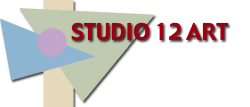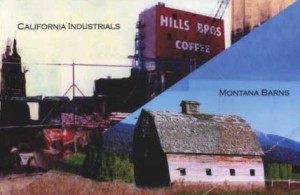Landscapes meld with industrial
objects in UC exhibit
review photo collage drawings in the UC Gallery at the University of Montana, April 28-May 12, 2006
by Ian Graham
printed April 28, 2006 in the Kaiman Arts, student newspaper at the U of Montana
Ever since cavemen scribbled illustrations of hunting trips on rock walls, artists have been searching for the perfect balance between the real and the imagined.
Leonardo da Vinci tried to perfectly recreate real life, Jackson Pollock did the opposite by portraying ideas without using “real” images, and every other artist has tried to find their place between those two extremes.
California native Peter Keefer found his niche by blurring the real and the abstract. In his current exhibits at the University Center Gallery, “Montana Barns” and “California Industrials,” he combines the ultra-real medium of photography with almost impressionistic drawings in what are called “photo-collage drawings.”
His interest in the style piqued (sic) in the late 1960s, while he was up in the Sierra Nevada taking landscape photos. He decided to take a panoramic series with his 300-millimeter lens and later made them into a collage.
After almost 10 years, he said, he turned the collages into the drawings he makes now.
The value of his work doesn’t come from the drawing itself as an interpretation of his photography. Rather, his deft blending of the “real” world in the photos and the “imagined” world of his drawings is what sets Keefer apart.
His theory is that by adding unusual nuances in the perspective, he’ll add depth to what would seem to be a plain landscape. He takes a normal object, like a barn, and alters the image to create a less logical and plain version of the object.
Once a viewer looks closely, they’ll notice the subtleties and quirks of each different painting.
“My interest is in the dichotomy of the perspective of the lenses and the perspective I can make by drawing,” he said. “I use a regular landscape line, if you will, but up close, you can see that the landscape has been rigged.”
In many cases, it’s difficult to tell where the photo ends and the drawings begin.
In “Broadway & Reserve Barn,” it’s only apparent after very close scrutiny that the fence around the barn is mainly drawn, not photographed.
“California Industrials,” a collection of collage drawings made from 1991 to 2003, shows (as the title suggests) Keefer’s interpretation of industrial settings in the Bay Area of California.
In some instances, he morphs industrial settings into post-apocalyptic images, the kind of strange landscapes reserved for anime and Gorillaz music videos.
“In one drawing, ‘Hills Bros. #2,’ in the background of the photos there are some concrete pillars,” he said. “But in my drawing, I turned them into lit-up towers and a train. Being able to blur the real and the imagined is easy with industrial settings.”
Viewing the collages and noting the date, it’s easy to follow Keefer’s drawing style.
For example, if his drawing “Hills Bros. #3” had been solely a reproduction of a photograph and presented on its own, it just wouldn’t be that impressive.
However, surrounded by more recent works (a collage of a Thompson Falls barn is only a few weeks old, Keefer said), the progress he’s made is apparent.
“Montana Barns” is a series he began in 2003 and is a localized version of his industrial landscapes.
The collages are based on photographs of barns all around western Montana, from Thompson Falls to Potomac Valley (along Highway 200 past Bonner) to Missoula.
After moving to Montana, Keefer saw that people couldn’t identify with the industrial images of San Francisco. It became apparent after a show at the Dana Gallery, he said. Nobody was as interested in his work as he thought, so he decided to adapt his work to Montana.
“I want to show a direction over time, going from industrial to bucolic, if you will,” Keefer said. “I’m influenced by where I’m at; I’m not stuck in a studio.”
In “Ashley Lake Road Barn,” a barn near St. Ignatius, his photographs tilt so that as they’re matched up, the barn tilts at an almost impossible angle. However, beyond the photographic distortions, “Montana Barns” is still in early development, lacking the transformed geography surrounding the barns.
“I started doing barns in 2003, so it’s still a pretty young idea,” he said. “I have the basic idea, I’m starting to work on how I can alter the landscape in my drawing. It’s kind of a vision in progress.”
“Montana Barns” and “California Industrials” will be on display in the UC Gallery through Friday, May 12.

